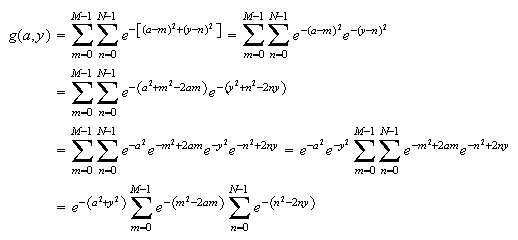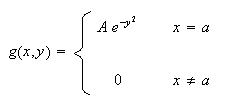 Suppose that the input to the system is an image consisting of a line of
infinitesimal width located at
Suppose that the input to the system is an image consisting of a line of
infinitesimal width located at
 and modeled by
and modeled by
 where
where
 is the impulse. Assuming no noise, find the output image
is the impulse. Assuming no noise, find the output image

HW 6, EECS 203A
Problem 5.16, Digital Image Processing, 2nd edition by Gonzalez, Woods.
Nasser Abbasi, UCI. Fall 2004
Question
Consider a linear position-invariant image degradation system with impulse
response
 Suppose that the input to the system is an image consisting of a line of
infinitesimal width located at
Suppose that the input to the system is an image consisting of a line of
infinitesimal width located at
 and modeled by
and modeled by
 where
where
 is the impulse. Assuming no noise, find the output image
is the impulse. Assuming no noise, find the output image

Solution
In general,
 where
where
 is the noise. Hence since
is the noise. Hence since
 ,
we have
,
we have

Now, I can solve this using spatial domain (convolution), or solve in Fourier
transform domain, then inverse transform to get
 .
I'll try the direct spatial approach:
.
I'll try the direct spatial approach:

where
 are the dimensions of the image
are the dimensions of the image

Since
 then
only when
then
only when
 ,
that we get a non-zero value for the the output image. At all other values for
,
that we get a non-zero value for the the output image. At all other values for


Hence

Since
 then Substitute
then Substitute
 we get
we get

How to evaluate these sums?
Since we are told that the input image is of infinitesimal width, then this
means we can consider the sum
 to have only one point. i.e.
to have only one point. i.e.

so

To continue, best I could do is to look up the tables for integrals, and use the results for
 where
where
 is the error function defined as
is the error function defined as

Hence, using these, we get

Since
 are constants, then
are constants, then
 is a constant, call it
is a constant, call it


Then
 where
where
 new
constant
new
constant

Notice that
 is a function of
is a function of
 as well, since constant
as well, since constant
 value depends on
value depends on
 via the equation given above for
via the equation given above for


I